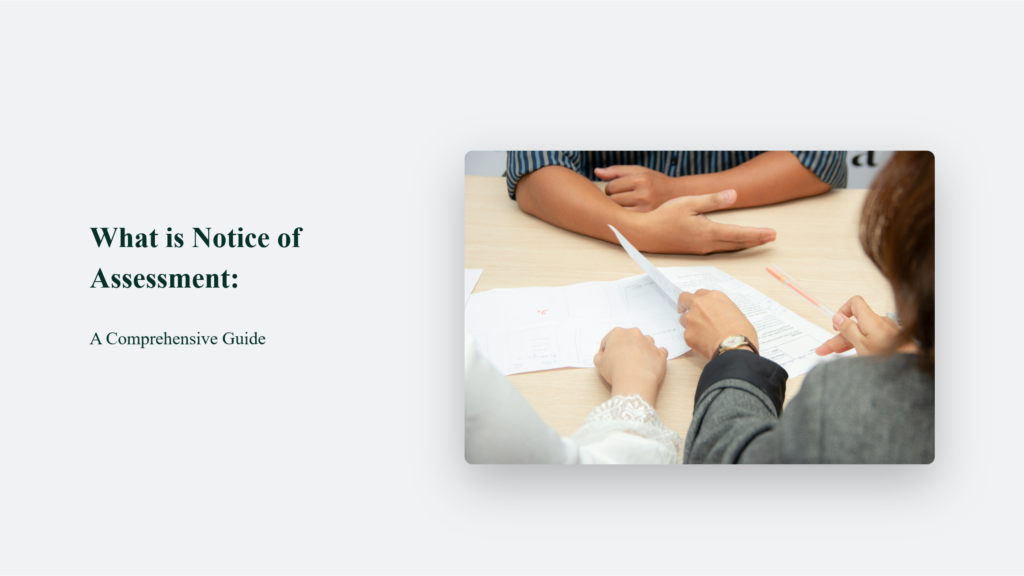

In the realm of taxation, receiving a notice of assessment (NOA) can evoke a mix of emotions, from relief to confusion. This crucial document, a bridge between taxpayers and the tax authorities, is a final statement on your tax situation for a given year. Yet, for many, its intricacies remain shrouded in mystery.
Let’s embark on a journey to demystify what is Notice of Assessment, transforming it from a source of perplexity to a beacon of clarity.

At its core, the Notice of Assessment is the taxman’s reply to your annual tax return. It’s an official statement detailing how much tax you owe, your refund amount (if applicable), and other vital tax-related information. Imagine it as the closing chapter of your yearly tax saga, providing a snapshot of your financial dance with the government.
Understanding the Notice of Assessment (NOA) is crucial for effective financial planning and tax management. The NOA, a cornerstone document issued by the tax authority after submitting your tax return, serves multiple purposes. Beyond merely indicating the amount of tax you owe or the refund you are entitled to, it offers valuable insights and information for future financial decisions. Here are the key insights into how the NOA can be a pivotal tool in your financial toolkit:
The Notice of Assessment is a direct response to your submitted tax return. Whether you choose the modern convenience of electronic filing or the traditional method of paper returns, the NOA signifies the culmination of your annual tax filing process. It is effectively the tax authority’s way of saying, “We’ve reviewed your submission, and here’s what we think”:
The NOA meticulously reviews the data you submitted, verifying or correcting it as necessary. It’s a critical document that confirms the government’s assessment of your tax obligations or refunds for the year, ensuring that both parties—taxpayer and tax authority—are aligned.
Far from being a mere statement of your past fiscal interactions, the Notice of Assessment holds keys to your financial future, particularly in areas like retirement planning and managing specific tax-advantaged plans:
One of the most valuable information the NOA provides is your updated RRSP (Registered Retirement Savings Plan) contribution room. This figure is crucial for planning your retirement savings, as it tells you how much you can contribute in the coming year without facing a penalty for over-contribution.
Understanding your RRSP contribution room allows for strategic financial planning, enabling you to maximise your retirement savings and minimise your tax liability.
The NOA is particularly important for individuals participating in the Home Buyer’s Plan (HBP) or the Lifelong Learning Plan (LLP). It informs you of your repayment obligations for the coming year.
These plans allow Canadians to withdraw from their RRSPs under specific conditions, stipulating that the borrowed amount must be repaid over time. The NOA provides detailed information on how much needs to be repaid and when crucial for maintaining the tax-advantaged status of your RRSP and avoiding potential penalties.
The Notice of Assessment is a cornerstone document in the realm of personal finance and taxation. It acts as the Canada Revenue Agency’s (CRA) official response to your tax return, detailing your tax situation for the year, including the total income assessed, taxes owed, or the refund you’re entitled to receive. Understanding and accessing your NOA is essential for several reasons:
If your NOA goes missing or you need to reference it, the CRA has made it easy to access this document. You can log into your CRA account online to view or download a copy of your NOA. This digital access ensures that you can always retrieve your NOA when needed, providing a convenient way to stay informed about your tax situation.
The tax refund is often the most anticipated part of the tax season for many taxpayers. It represents a return of overpaid taxes throughout the year, effectively acting as a forced savings plan that pays out once your return is processed. Here are key aspects of tax refunds:
Understanding your Notice of Assessment and anticipating a tax refund are integral parts of the tax filing process. Here are a few tips to maximise your experience:
By delving into the nuances of the Notice of Assessment, we shed light on its importance as a summary of your tax situation and as a tool for future financial planning. Whether you’re a seasoned taxpayer or new to the game, understanding your NOA can significantly impact your financial journey, offering insights and opportunities to optimise your tax strategy and enhance your financial well-being.
You have 90 days from the date of the assessment to file an objection. This is your right to challenge the CRA’s conclusions and present your case.
Absolutely. It provides valuable information, such as your RRSP contribution room, that can influence your financial decisions and tax strategies for the coming year.
Yes, if you find discrepancies or errors, you can request an amendment within the stipulated timeframe to ensure your tax records accurately reflect your financial situation.